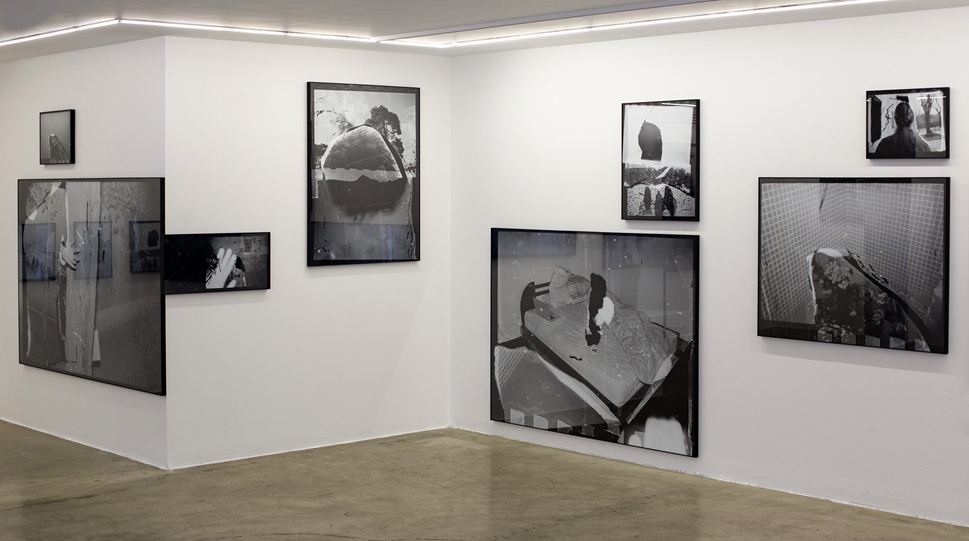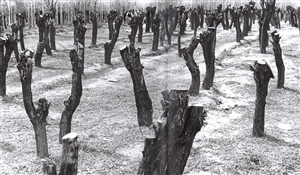On Alborz Kazemi's Solo Show at Dastan's Basement
19 Dec 2021Original text in Farsi by Amir Esfandiari
Translated to English by Soheila Habibi
None Turned into Memory
Dastan's Basement hosted a new show by Alborz Kazemi (1989) entitled "None Turned into Memory," curated by Vatan Project on December 3, 2021. This show continues until December 17. "None Turned into Memory" includes Kazemi's photo collages, which somehow line up with his recent experiences with the image.
Kazemi has previously participated in solo and group shows in Iran and abroad. He has explored his intimate life in his past works and collections. As an artist who seeks to understand and generalize his personal issues to a public realm, he has turned to taking photographs of family and friends in his early collections. He also has expanded this process to capture other moments and situations. In later experiments, he turned to photocollage and photography of two-dimensional images, mostly pre-photographed, and paid particular attention to the 'body' and its encounters with other bodies, objects, and places. Kazemi's photographs and collages are often made by the analog process. The use of analog photography is evident in his works, especially in the "None Turned into Memory" series.
The process of forming the "None Turned into Memory" collection follows the previous experiences of the photographer. This collection includes photographs and photocollages of Kazemi in black and white, which seem to be directly related to the distant memories and moments of the artist that have been captured by him over time.

Alborz Kazemi | Installation view of "None Turned into Memory" at Dastan's Basement
In the attached note to the show, the Vatan Project explores disturbing and unrecorded memories that surround the lives and leave a scar on the soul. In this ironic text, the word "danger" or "khátár" in Persian is used as the root of the word "memory" or "khâtereh" in Persian. It is further assumed that the word "memory/khâtereh" (which here the image bears the burden of carrying it) is used to avoid danger/khátár; or anything else that has the same root as memory/khâtereh. As it turns out, the present collection is defined in relation to the artist's personal memories. This relation may seem a little strange in a curatorial project. What is very personally recorded for the artist is redefined by the presentation in a context far remote from those events and situations. This time, memories pop out and reveal themselves, like wounds, by leaving the artist's safe zone.
The installation of the works at Dastan's Basement seems messy at first glance. Works are installed in different sizes and in different corners of the gallery. The installation is in such a way that some of the pieces mounted on the wall can be seen side by side and as the other's complementary.

Alborz Kazemi | Installation view of "None Turned into Memory" at Dastan's Basement
As mentioned, the works of this collection, like the artist's previous works, have a personal atmosphere; however, this time, it seems a bit difficult to find the space or objects photographed among the images. Each work is divided into different pieces of different photographs, containing more and more different parts than before. But with a little bit of detail, we come across familiar elements in Kazemi's photography, examples of which we have seen in the artist's previous collection. Elements such as body and parts of the face, hair and facial hair, and objects such as vases, chairs, beds, foliage, etc. are placed in the works as if they are the messy parts of the artist's images or memories. The use of places such as bedroom intensifies this sense of familiarity and comfort in the photographed environment.
Most of the images selected to make the collages of the collection are such that they do not create a sense of pre-made and staged. They are primarily simple images with a touch of amateur and snapshot photography that have undergone changes in use, and the photographer has photographed and archived them throughout his life. They are detached from their original context and can no longer claim to record a fact from a decisive moment. The artist distorted some of the images and left wounds on their bodies by manipulating, cutting, and pasting. Wounds reminiscent of a repetitive sentence in the attached text:
"I have a burn mark on my body!"

Alborz Kazemi | Untitled | 2021 | c-print on fine art paper | 80 × 110 cm
With a careful look, we see that some of the pictures are repeated in the installation. On the other hand, the details of each piece, in high contrast of black and white, show them a little similar to each other; in such a way that some images can be imagined in each other. This procedure shows different perceptions, and of course, various aspects of a single image that can have further applications in different contexts. Their placement will lead to the production of other images with different meanings. These are different aspects of a photo that oppose a still image and disable it to create the illusion of reality in this collection.
The works of "None Turned into Memory" do not seek to make a memory in the familiar and positive sense of it, from intimate events and photographs, but to find a purpose in encountering them by fragmenting, destroying, and damaging them. This time, and finally, with another look at the installation, the photos justify their irregularity in the gallery environment.
"None Turned into Memory" is full of fragmented bodies, acquaintances, personal moments, and places that are all somehow lost and on the verge of extinction. They are vague memories that have been emptied of their reality or placed in opposition to the photographer himself. A situation in which places, people, and memories forget their role and get lost in each other; in a new position, they remind what was called "danger/khátár" in the attached text.
Notice the unclear photographed polaroid, the woman whose hair we see, the blurred face of a man, or the hand in front of a face. "None Turned into Memory" is replete with moments of wandering in injured dangers and takes the audience along this path.






